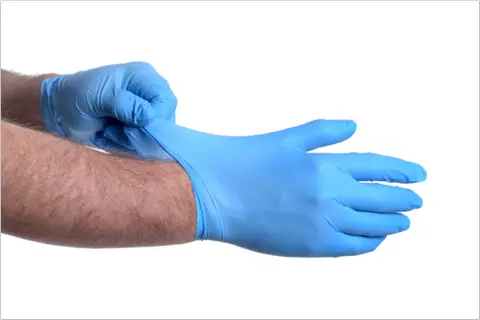As we all know the importance of disposable gloves and how they have aided us against this deadly virus during the pandemic.
We have seen this growing demand for gloves because of the covid-19, however, these disposable gloves have long been in use in the medical industry and food sector for decades.
There are various ways to make your disposable gloves tighter so that it fits you better. You can try to run the gloves under hot water, else boil water in a pan and once it comes to boiling point, put the gloves inside and let it immerse for sometime. You can also use a hair dryer to shrink your disposable gloves to make it tighter.

Latex and nitrile gloves are made of rubber, and if gloves made of these materials are loose, you can always follow some home remedies to sort this out.
So let’s talk about the above points in detail.
1.) Shrinking disposable gloves using hot water
Put the disposable gloves under running hot water. If the rubber is sufficiently weak, the water will ultimately compel it to constrict and shrink.
2.) If hot tap water does not work, boiling the rubber may be more effective
If hot tap water fails to shrink the rubber, immerse it in boiling water. If you leave it to boil for 5 to 10 minutes, the intense heat will cause the glove to shrink.
3.) Using a blow dryer to shrink disposable gloves
Put the glove on a heat-resistant surface. Make sure you don’t come into touch with the glove when heating it up.
Wearing eye protection and a dust mask will protect you from the heat and the potential toxic air. While the risk is limited because it is only a blow dryer, taking precautions is always a good idea.
Turn on the blow dryer’s maximum heat setting. You’ll want to make sure you’re shrinking the glove properly.
Make an effort to be as consistent as possible, distributing the heat evenly so that it may fully permeate the glove and shrink it uniformly all around. Heat for approximately 5 minutes, or longer if required.
The glove may begin to smell somewhat. While it is exceedingly unusual, look for evidence of damage or darkening on the glove to ensure that you are not burning it.
Allow the glove to cool completely before handling it. Because the heat necessary to shrink the glove can be dangerous, it is advisable to wait for it to cool.
Understand the importance of proper fitting gloves
While selecting the appropriate glove grade and material for operations is critical, ensuring that gloves fit properly and are the correct size may make all the difference in terms of user comfort and contamination prevention.
1.) Having a properly fitted glove is one of the most crucial aspects, especially if you’re wearing it for safety.
2.) Gloves that do not fill properly raise the risk of harm or infection.
3.) If your glove is too large, the loose fitting material will limit your dexterity and grip. And if your glove is too small, you risk tearing or puncturing it, as well as having less hand flexibility.
Drawbacks of loose fitting gloves:
1.) While certain gloves are inherently loose fitting, gloves that are excessively loose fitting might allow gloves to fall off while in use, exposing bare hands to food or medical equipment.
2.) Because of their loose fit to the wearer’s skin, they may also provide insufficient protection against pollutants. If the gloves appear to be overly long or wide, they are most certainly too large.
3.) Loose-fitting gloves can be unpleasant and cause skin discomfort or chafing.
4.) They can also result in reduced grip and handling control, making detailed jobs harder and putting unneeded pressure on the wearer’s hands.
Drawbacks of tight fitting gloves:
1.) Nitrile, latex gloves are made to be form fitting to prevent gloves from falling off while being used.
2.) Gloves that are overly tightly fitted, on the other hand, may rip or tear while in use, placing users, customers, or patients at danger of contamination and resulting in glove waste.
3.) If you put on gloves and notice that the material is strained, or that it feels too tight, or there are already rips or tears forming, the glove is too small and you should look into larger size possibilities.
4.) Gloves should always allow for freedom of movement and should not impose strain on the wearer’s hands or fingers.
A smart way to ensure that your gloves fit properly is to:
1.) Extend your fingers till they are straight while wearing gloves. If the nitrile or latex on your gloves is straining, they are too small. If you see rips forming in the cloth where your thumb meets your palm, your glove is too small.
Some important points before we bid farewell.
1.) To prevent contamination and to guarantee that gloves are providing quality protection, always ensure that they are donned and removed properly. If gloves get ripped or damaged while being worn, they must be removed immediately.
2.) Another key part of using disposable gloves is hand cleaning. To keep hands and surfaces clean, ensure that they are washed before and after wearing disposable gloves.
Here are a few tips for you on how to wear and dispose your disposable gloves properly-
1.) Always keep hygiene in mind, and you will guarantee that your gloves are worn properly.
2.) Make sure to put on your gloves when you have clean hands. By putting your gloves on a filthy surface, you are infecting them.
Never put on nitrile or latex gloves if you haven’t already cleansed your hands. Contaminants on your hands will be transferred to and via the glove.
3.) It’s also a good idea to take off any watches, rings, or other jewellery from your hands before putting on your gloves. This is an extra precaution to avoid any inadvertent rips or tears in the glove.
4.) To keep the gloves clean, avoid touching the outer layer while putting them on. To begin, place the nitrile or latex glove on your dominant hand while touching it as little as possible.
Then, place the other glove on your non-dominant hand, pulling it on with your gloved dominant hand. Once you’ve got both gloves on, you may adjust your fingers and the fit of the glove.
How to remove disposable gloves properly-
1.) The most essential thing to remember when removing your gloves is to avoid touching the outside of the glove, as this might result in undesirable liquids or chemicals getting on your skin.
2.) Again, starting with your dominant hand, take the other glove off your hand without contacting the outside. Then, proceed with caution, removing the glove from your other hand using your dominant hand.
Conclusion
Since we know the importance of disposable gloves, we wouldn’t want to waste even a single piece.
So if your hands are small and you worry no glove is ever going to fit you properly, then you might want to read this article nicely because we have a solution here for you.
Follow the instructions properly and remember to be cautious.







